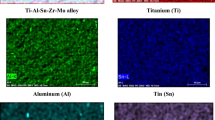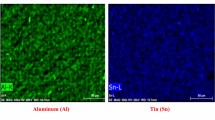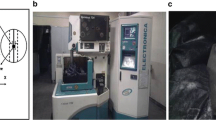Abstract
Ti–6Al–4V is a popular titanium alloy, finding wide application mainly in aerospace and biomedical applications. Due to its high strength and toughness, wire cut electrical discharge machining (WEDM) is used for macro- and micro-machining of these materials. In this work, WEDM experiments on Ti–6Al–4V are conducted using Taguchi L16 OA with four process parameters, viz. pulse on time (Ton 13, 20, 27, 34 µs), pulse off time (Toff 4, 6, 8, 10 µs), current or applied current (I 1, 2, 4, 5 A) and wire speed (WS 350, 700, 1050, 1400 rpm). The novelty of this work is to evaluate two important sustainable measures, i.e., material removal rate (MRR) for economic concern and power consumption (PC) for environmental concern, in the production of WEDM components. The machining process cycle of WEDM process is described step by step. The power consumption during machining is evaluated by measuring line current using digital clamp meter. Regression models developed were found to be highly accurate with model accuracy of 98.34 and 94.03% for PC and MRR, respectively. Experimental investigation shows that I and Toff are found to be significant factors influencing MRR and PC. Parametric variation of response surface of MRR and PC is also studied using surface plots. SEM images of the machined surface at cutting conditions corresponding to maximum MRR and minimum PC are also studied. Desirability function analysis (DFA) is employed to simultaneously optimize the responses. The process parameters are optimized using DFA, and results show an improvement in composite desirability (CD) by 7.88% at optimum parameter setting of Ton 20 µs, Toff 6 µs, I 2 A and WS 1050 rpm. The performance measures at optimum parameter show improvement of 9.77 and 6.40% for MRR and PC, respectively.











Similar content being viewed by others
References
Harmanpreet, Manpreet S (2015) Influence on kerf width in machining polystyrene by heating element profile maker using nichrome wire. Int J Eng Res Technol (IJERT) 4(4):135–140
Gao S, Huang H (2017) Recent advances in micro- and nano-machining technologies. Front Mech Eng 12(1):18–32. https://doi.org/10.1007/s11465-017-0410-9
Patil PA, Waghmare CA (2014) A review on advances in wire electrical discharge machining. In: Proceedings international conference on research and innovations in mechanical engineering. https://doi.org/10.1007/978-81-322-1859-3-16
Gianluca T, Giuliano B, Andrej L (2015) Real time power consumption monitoring for energy efficiency analysis in micro EDM milling. Int J Adv Manuf Technol 78:1511–1521. https://doi.org/10.1007/s00170-014-6725-3
Danial G, Abolfazl G, Izman S (2014) Multi-objective process optimization of wire electrical discharge machining based on response surface methodology. J Braz Soc Mech Sci Eng 36:301–313
Rupesh C, Jatinder K (2016) Investigation of the machining parameters and integrity of the work and wire surfaces after finish cut WEDM of commercially pure titanium. J Braz Soc Mech Sci Eng 38:883–911
Anish K, Vinod K, Jatinder K (2015) Semi-empirical model on MRR and overcut in WEDM process of pure titanium using multi-objective desirability approach. J Braz Soc Mech Sci Eng 37:689–721
Ghodsiyeh D, Golshan A, Hosseininezhad N, Hashemzadeh M, Ghodsiyeh S (2012) Optimizing finishing process in WEDMing of titanium alloy (Ti6Al4V) by zinc coated brass wire based on response surface methodology. Indian J Sci Technol 5(10):3365–3377
Farnaz N, Rajurkar KP, Malshe AP, Jian C (2013) Wire electro-discharge machining of titanium alloy. Proc CIRP 5:13–18
Rajyalakshmi G, Venkata P (2013) Multiple process parameter optimization of wire electrical discharge machining on Inconel 825 using Taguchi grey relational analysis. Int J Adv Manuf Technol 69:1249–1262
Kasim MS, Ghani JA, Izamshah R, Anand TJS (2015) Modeling and optimization of cutting parameter during wire-EDM of Inconel 718 using response surface methodology. Chin J. https://doi.org/10.13140/RG.2.1.2366.6725
Amitesh G, Jatinder K (2014) Investigation of surface integrity, material removal rate and wire wear rate for WEDM of Nimonic 80A alloy using GRA and Taguchi method. Eng Sci Technol Int J 17:173–184
Huang Y, Ming W, Guo J, Zhang Z, Liu G, Li M, Zhang G (2013) Optimization of cutting conditions of YG15 on rough and finish cutting in WEDM based on statistical analyses. Int J Adv Manuf Technol 69:993–1008
Shao HC, Chen PW (2014) Using the zero-resistance spark circuit on the wire cut electric discharge machine to realize energy savings. Intell Precis Manuf Autom Technol 3(4):128–133
Liao YS, Woo JC (2000) Design of a fuzzy controller for the adaptive control of WEDM process. Int J Mach Tools Manuf 40:2293–2307
Gianluca T, Giuliano B, Andrej L (2014) Real time power consumption monitoring for energy efficiency analysis in micro EDM milling. Int J Adv Manuf Technol 78:1511–1521. https://doi.org/10.1007/s00170-014-6725-3
Ram Prasad AVS, Ramji K, Datta GL (2014) An experimental study on Wire EDM on Ti–6Al–4V alloy. Proc Mater Sci 5:2567–2576
Azhiri RB, Teimouri R, Baboly MG, Leseman Z (2014) Application of Taguchi, ANFIS and grey relational analysis for studying, modeling and optimization of wire EDM process while using gaseous media. Int J Manuf Technol 71:279–295
Girish K, Kuldip SS (2015) Predictive modeling for energy consumption in machining using artificial neural network. Proc CIRP 37:205–210
Hui D, Dengyue G, Kai C, Qi C (2014) An investigation on quantitative analysis of energy consumption and carbon foot print in the grinding process. J Eng Manuf 228(6):950–956
Sibalija TV, Majstorovic VD (2012) An integrated approach to optimize parameter design of multi-response processes based on Taguchi method and artificial intelligence. J Intell Manuf 23:1511–1528
Shrivastava PK, Dubey AK (2013) Intelligent modeling and multi objective optimization of electric discharge diamond grinding. Mater Manuf Processes 28:1036–1104
Tamang SK, Chandrasekaran M (2016) Integrated optimization methodology for intelligent machining of Inconel 825 and its shop-floor application. J Braz Soc Mech Sci Eng 39:865–877. https://doi.org/10.1007/s40430-016-0570-2
Harrington J (1965) The desirability function. Ind Qual Control 21(10):494–498
Derringer GC, Suich D (1980) Simultaneous optimization of several response variables. J Qual Technol 12(4):214–219
Sengottuvel P, Satishkumar S, Dinaran D (2013) Optimization of multiple characteristics of EDM parameters based on desirability approach and fuzzy modeling. Proc Eng 64:1069–1078
Reddy S (2014) Optimization of machining parameters during end milling of GRFP composites by desirability function analysis using Taguchi technique. In: 5th international & 26th all India manufacturing technology, design and research conference, 12th–14th December 2014. IITG, India
Chandrasekaran M, Shiv S, Thirumalai R (2015) Experimental investigation and shop floor need based multi characteristics optimization for machining GFRP composites using PCD. Int J Front Technol 2(2):10–17
Ramanujam R, Lohithaksha MM, Venkatesan K, Mithun V (2014) Multi response optimization using ANOVA and desirability function analysis: a case study in end milling of Inconel alloy. ARPN J Eng Appl Sci 5(4):457–463
Acknowledgements
The authors acknowledge the financial support received from NERIST, Arunachal Pradesh, under TEQIP-II scheme and WEDM experimental facility at BMS College of Engineering, Bengaluru, in carrying out the research. The first author also acknowledges the support received from AICTE-NEQIP scheme of Rajiv Gandhi Govt. Polytechnic, Itanagar, Arunachal Pradesh.
Author information
Authors and Affiliations
Corresponding author
Additional information
Technical Editor: Márcio Bacci da Silva.
Rights and permissions
About this article
Cite this article
Devarajaiah, D., Muthumari, C. Evaluation of power consumption and MRR in WEDM of Ti–6Al–4V alloy and its simultaneous optimization for sustainable production. J Braz. Soc. Mech. Sci. Eng. 40, 400 (2018). https://doi.org/10.1007/s40430-018-1318-y
Received:
Accepted:
Published:
DOI: https://doi.org/10.1007/s40430-018-1318-y




